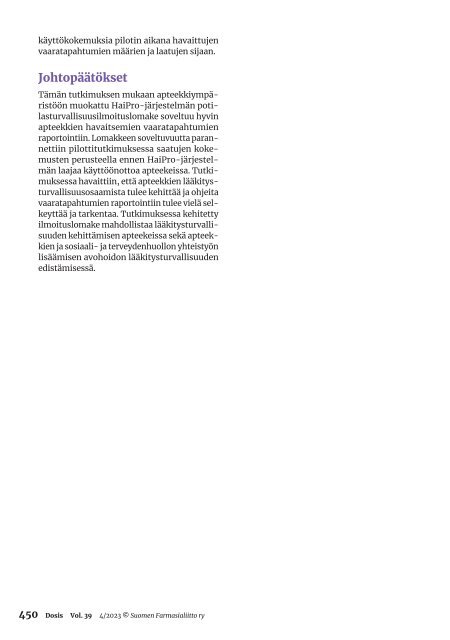DOSIS 4/2023
Farmaseuttinen aikakauskirja DOSIS 4/2023 vol.39 5uomen Farmasialiitto ry
Farmaseuttinen aikakauskirja DOSIS 4/2023 vol.39 5uomen Farmasialiitto ry
You also want an ePaper? Increase the reach of your titles
YUMPU automatically turns print PDFs into web optimized ePapers that Google loves.
käyttökokemuksia pilotin aikana havaittujen<br />
vaaratapahtumien määrien ja laatujen sijaan.<br />
Johtopäätökset<br />
Tämän tutkimuksen mukaan apteekkiympäristöön<br />
muokattu HaiPro-järjestelmän potilasturvallisuusilmoituslomake<br />
soveltuu hyvin<br />
apteekkien havaitsemien vaaratapahtumien<br />
raportointiin. Lomakkeen soveltuvuutta parannettiin<br />
pilottitutkimuksessa saatujen kokemusten<br />
perusteella ennen HaiPro-järjestelmän<br />
laajaa käyttöönottoa apteekeissa. Tutkimuksessa<br />
havaittiin, että apteekkien lääkitysturvallisuusosaamista<br />
tulee kehittää ja ohjeita<br />
vaaratapahtumien raportointiin tulee vielä selkeyttää<br />
ja tarkentaa. Tutkimuksessa kehitetty<br />
ilmoituslomake mahdollistaa lääkitysturvallisuuden<br />
kehittämisen apteekeissa sekä apteekkien<br />
ja sosiaali- ja terveydenhuollon yhteistyön<br />
lisäämisen avohoidon lääkitysturvallisuuden<br />
edistämisessä.<br />
Summary<br />
Development of HaiPro patient safety<br />
incident reporting form for community<br />
pharmacies – A Pilot study<br />
Mira Luostarinen*<br />
M.Sc. (Pharm), Expert Pharmacist<br />
New Pharmacy of Kuopio<br />
mira.luostarinen@gmail.com<br />
Tuula Teinilä<br />
M.Sc. (Pharm), Pharmacy Owner<br />
Pharmacy of Aulanko, Hämeenlinna<br />
Koskenkorva Tiina<br />
M.Sc. (Pharm), Expert Pharmacist<br />
Association of Finnish Pharmacies<br />
Piia Siitonen<br />
Ph.D. (Pharm), University Lecturer<br />
University of Eastern Finland<br />
* Correspondence<br />
Introduction<br />
The patient safety incident reporting procedure<br />
is one of the key means of identifying and<br />
managing risks associated with medication use<br />
process. The reporting of medication safety<br />
incidents between pharmacies and social and<br />
health care organizations enables utilisation<br />
of information and cooperation in improving<br />
the safety of outpatient medication use process.<br />
One of the key projects of the National<br />
Medication Safety Programme for Pharmacies<br />
in Finland (2021-2026) is implementing of the<br />
patient safety incident reporting system HaiPro<br />
in Finnish community pharmacies. This pilot<br />
study was carried out as part of this program.<br />
HaiPro is a voluntary electronic reporting system<br />
for patient and medication safety incidents<br />
and is commonly used in social and health care<br />
organisations in Finland. The aim of the study<br />
was to develop the HaiPro patient safety incident<br />
reporting form suitable for use in community<br />
pharmacies. In addition, the aim was<br />
to explore the experiences of pharmaceutical<br />
staff on using the implemented HaiPro patient<br />
safety incident reporting form.<br />
Material and methods<br />
In this study, the HaiPro patient safety incident<br />
reporting form was modified to reflect<br />
the locations and types of medication errors<br />
detected by community pharmacies. In addition,<br />
new types and places of event were added<br />
to the form, such as dose dispensing, self-care,<br />
and remote services. The form was piloted in<br />
18 Finnish pharmacies for four weeks in spring<br />
2021. Experiences of the form's usability were<br />
asked on the Likert scale and with open-ended<br />
questions. The responses were analyzed using<br />
frequency distributions and cross-tabulation.<br />
Open-ended responses were analyzed using<br />
content analysis. The incident reporting form<br />
was modified to the final form based on the<br />
experiences of the users.<br />
Results<br />
In total, 147 HaiPro incident reports were<br />
reported from the study pharmacies. The most<br />
common types of medication errors were prescription<br />
errors (n = 61) and dispensing errors<br />
(n = 58).<br />
The participants gave proposals for the<br />
improvement of the incident reporting form,<br />
which were used to solve technical issues and to<br />
further develop the usability of the form, e.g.,<br />
enabling simultaneous reporting of prescription<br />
and dispensing errors, adding a collecting<br />
error as a type of event and developing the<br />
medicine product database.<br />
93% of the participants reported that using<br />
the incident reporting form was successful or<br />
somewhat successful. However, based on the<br />
incident reports, some participants had difficulties<br />
in classification of both the nature of the<br />
event and the places of the incident.<br />
Conclusions<br />
The HaiPro patient safety incident reporting<br />
form is well suited for reporting of medication<br />
safety incidents detected in pharmacies.<br />
The study found that community pharmacists’<br />
competence in medication risk management<br />
needs to be enhanced. Also, the instructions<br />
for the reporting of incidents needs to be clarified<br />
and specified. The patient safety incident<br />
reporting form developed in this study enables<br />
the development of medication safety in pharmacies<br />
and the strengthening of collaboration<br />
450 Dosis Vol. 39 4/<strong>2023</strong> © Suomen Farmasialiitto ry Suomen Farmasialiitto ry © 4/<strong>2023</strong> Vol. 39 Dosis 451
















